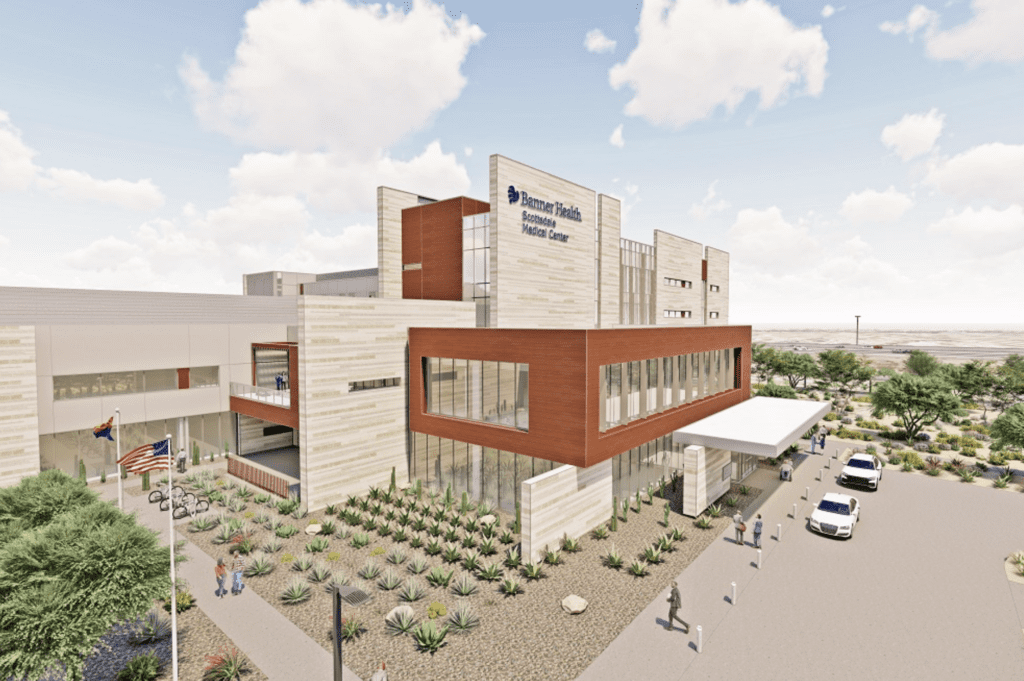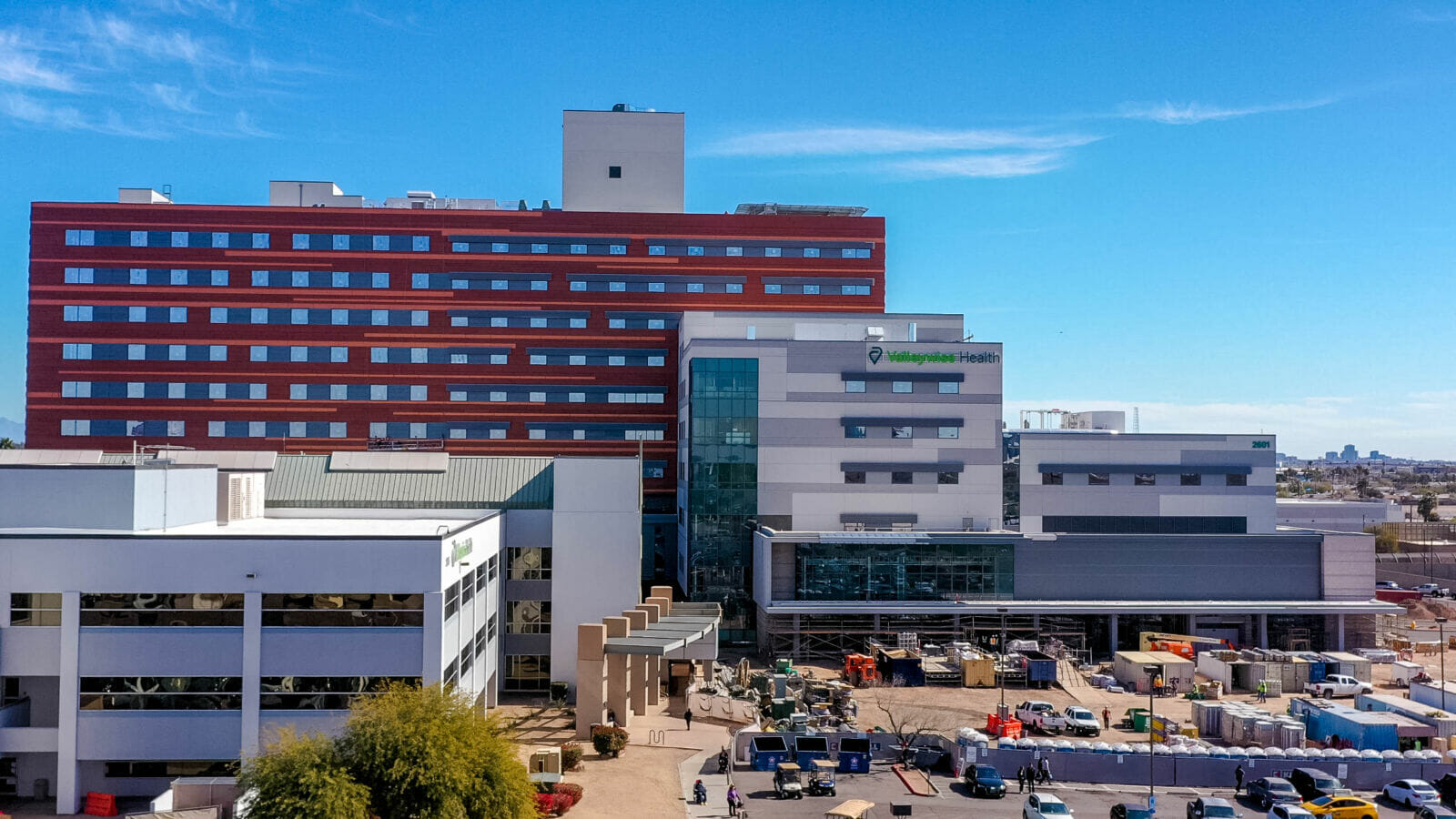In 1975, the O’Jays released “Give the People What They Want” and it became a hit song for the group and paved the way for the R&B group’s induction into the Rock and Roll Hall of Fame in 2005. Despite the passage of nearly 50 years, the group’s seminal message may be more relevant than ever, particularly when it comes to Metro Phoenix hospital development.
RANKING ARIZONA: Top 10 hospitals for 2023
“The big difference in hospital development and construction today is we’re bringing healthcare to the people,” says Robert Cortazzo, Southwest president for Adolfson & Peterson Construction, which is working on multiple healthcare projects in Metro Phoenix. “In the past, people would have to drive — 5, 10, 15 miles — to a healthcare facility to see their doctor or have a treatment. Today, you see a lot of local healthcare providers and national healthcare providers putting facilities in the neighborhoods where the people are. So they’re taking their product and putting it in the middle of neighborhoods and communities to make it more convenient for the residents in those areas.”
And if you drive through neighborhoods in Metro Phoenix — particularly in the West Valley, which is home to five of the 10 fastest-growing Arizona cities — you’ll see healthcare projects popping up in neighborhoods that are clamoring for healthcare services.
“Nationally, bringing healthcare into the communities is a growing trend,” says Larissa Spraker, vice president of strategy and business development for Dignity Health’s Arizona market. “In Arizona, and in Maricopa County in particular, it has almost been a scenario of ‘if you build it they will come.’ The difference in the past decade is we’ve seen a significant effort to expand healthcare services into the communities and areas of the market where the people reside, as well as accommodation for inpatient care at home and increased access to urgent/emergency care, post acute services such as inpatient rehabilitation and inpatient behavioral health care.”
Banner is Booming
And in Arizona, healthcare providers are building new facilities and new residents are coming — in droves. Banner Health, the largest employer in Arizona, has seen an increase in the development of new healthcare facilities that parallels the rapid growth in the state’s population.
“Banner has grown considerably in recent years through acquisitions, expansions and new developments,” says Scott Nordlund, executive vice president and chief strategy and growth officer for Banner Health. “This growth has been driven by population growth as well as growth of our Banner plans and networks, which now covers more than 1 million lives through commercial and government insurance plans and broad networks that provide comprehensive coverage throughout Arizona.”
Already in 2023, Banner has unveiled expansions and new developments to service Arizona’s increasing population. Those projects include:
• A new women’s tower opened at Banner Desert Medical Center in Mesa in January 2023. This expansion added 148 state-of-the-art inpatient rooms, including a new Labor & Delivery unit, and 108 medical/surgical rooms dedicated to women’s care and recovery.
• Banner Health Center plus, located at 44th Street and Camelback Road in Phoenix, opened in February 2023. This is the second location of Banner’s newest ambulatory care model, which combines urgent care and family medicine with a full array of specialists, along with advanced imaging, laboratory services, physical therapy, executive health care and sports medicine all in one location.
• A new patient tower at Banner Gateway Medical Center in Gilbert opened in March 2023. This 351,000-square-foot addition includes an expanded Women and Infant Services Unit, added space for inpatient cancer care by Banner MD Anderson Cancer Center (located on the same campus), and more space for surgical, emergency, endoscopy and imaging services. Licensed inpatient beds at Banner Gateway increased from 177 to 286.
• Other projects currently in development are Banner Sports Medicine Scottsdale, which is slated to open in May 2023, and an expansion of operating rooms at Banner – University Medical Center Tucson, which will be completed in 2024.

Healthy dose of development
Banner is not the only healthcare organization experiencing a building boom.
“Our investment in advanced neonatal services at Abrazo Arrowhead Campus meets a need for young families in a growing part of the Valley,” says Abrazo CEO Brian Elisco. “We are also excited about the new Phoenix Children’s Hospital – Arrowhead that is under construction next to Abrazo Arrowhead Campus. PCH’s new Glendale hospital will be an excellent complement to our women’s and neonatal services at Abrazo Arrowhead.”
Elisco says some of the projects Abrazo Health has underway, recently completed and planned for the future include:
• In Buckeye, Abrazo Health has acquired a 27-acre property to develop a medical campus at I-10 and Verrado Way. Plans for the campus include a medical office building, ambulatory services and a future acute care hospital. “We are excited about the interest in this new campus from physicians and the community,” Elisco says. “Planning is underway on the first phase of development, which will be a three-story medical office building.”
• In the Northwest Valley, Abrazo Arrowhead Campus in Glendale is in the midst of a $14 million expansion of its neonatal unit for preterm babies. The 8,500-square-foot addition will increase the unit’s size from 21 to 35 beds, and support enhanced capabilities to pursue certification as a higher Level IIIB Neonatal Intensive Care Unit for more complex maternal and neonatal medical conditions, obstetric and fetal complications.
• Abrazo Health has opened two new neighborhood hospitals, or microhospitals as they are sometimes called, in Cave Creek and Surprise. They are smaller in scale than a typical acute care hospital, yet offer a full emergency department, inpatient care, imaging suites and procedure rooms. They bring a higher level of care into these communities so patients can receive much of their medical care closer to home.
And in April, HonorHealth broke ground on a $170 million expansion project at HonorHealth Deer Valley Medical Center. The project will feature additional patient beds, operating rooms and the expansion of key support departments.
“Our commitment to expanding the HonorHealth Deer Valley Medical Center campus is critical to help us support the needs of the growing North Phoenix community and provide them with access to high-quality care close to home,” says Todd LaPorte, CEO of HonorHealth. “By continuing to invest in key services and providing infrastructure to help us expand, both now and in the future, we will be able to grow alongside our community.”
Historic levels of Phoenix hospital development
Dignity Health is also looking to the future needs of patients with multiple projects in the works or recently completed.
“Dignity Health is anticipating the acquisition of 40 acres in Surprise, at the southwest corner of Greenway and Loop 303,” Spraker says, “for a future healthcare campus featuring adult acute care, emergency and surgical services, and various ambulatory and diagnostic services to support the growing community and meet any gaps in healthcare services that may exist.”
In addition, Dignity’s other recent therapeutic developments and expansions include the opening of a new patient bed tower and six new operating rooms at Chandler Regional Medical Center; and the opening of Dignity Health East Valley Rehabilitation Hospital in Gilbert in January 2023.
“Later this year,” Spraker says, “a women’s and children’s pavilion at Dignity Health Mercy Gilbert Medical Center will open in partnership with Phoenix Children’s Hospital adding new labor and delivery suites, ante-and postpartum rooms, a Level III neonatal intensive care unit; and pediatric emergency services, inpatient/ICU and surgical services.”
If this all sounds like a lot of development, that’s because we are seeing historical highs when it comes to hospitals being built in Metro Phoenix.
“Most of the healthcare systems have been expanding bed space and service lines on their existing Phoenix campuses,” says Katie McIntyre, vice president at JLL. “We are also seeing new acute-care hospital campuses being developed and an explosion of new inpatient rehabilitation hospitals.”
To put the hot hospital development market into perspective, McIntyre says there were five new acute-care hospitals built in Metro Phoenix in the past 10 years. And today, there are five under development — Banner Health and Abrazo Health in Buckeye, Phoenix Children’s Hospital in Glendale, Exceptional Hospital in Maricopa and Peoria Regional Hospital — and two more proposed to break ground this year — Dignity Health in Surprise and Banner Health in Scottsdale.
“In the past 10 years, there has also been an explosion of post-acute care rehabilitation hospitals with 11 new hospitals and we are aware of several more in the planning stages,” McIntyre says.”
Location, location ,location
While it’s clear that there has been a surge in new hospital development in Metro Phoenix, how do healthcare leaders decide which locations are prime for expansion or which locations are in the greatest need for new healthcare services?
“We collaborate with community physicians, and business and community leaders who serve on our hospitals’ boards of governors who provide valuable input on local healthcare needs,” Elisco says. “Population growth and shifting demographics also play a role in planning for expansion of current facilities and new locations such as our future Buckeye medical campus. Overall the Valley is still one of the fastest growing metros in the nation. Our vision is to consistently deliver the right care, in the right place, at the right time and to be a premier employer, where patient care and saving lives are our focus.”
Nordlund says Banner does regular and thorough assessments in all its markets to determine if existing services are meeting the healthcare needs of the community, and to project future growth needs.
“We want to anticipate those needs and thoughtfully develop ahead of them to ensure that healthcare demand does not exceed supply,” Nordlund says. “In addition to population growth, as a payor and provider, Banner also considers its members when making decisions about new facilities or expansions. We want to ensure that we are meeting all their access and care needs.”
In large markets, such as the Phoenix metropolitan area, Nordlund says Banner divides the market into submarkets with a goal to create ecosystems of care in each submarket. This includes acute care, urgent care, imaging, physical therapy, ambulatory surgery, pharmacy, lab and physician services.
“We want to provide the full continuum of care for people who live and work in those submarkets so that they do not have to travel far for what they need,” he says.
On the design side of Phoenix hospital development
While population growth has impacted the need and acceleration of new hospital development and existing facility expansion, the advent of COVID-19 and other external factors have presented new challenges and changed the way hospitals are designed and constructed.
“Healthcare systems have been hit with a tsunami of challenges — labor and supply costs and bleak operating margins that have carried over from 2022 and into 2023 — that are impacting their ability to justify the funding of new projects,” says Craig Passey, Phoenix Healthcare Studio leader for SmithGroup. “The continued construction market volatility — labor cost escalation, material availability and lead times, material costs, etc. — have made it increasingly more challenging to align project scope with budget.”
Passey knows this very well. SmithGroup has worked on a number of recent high-profile medical projects, including Banner Ocotillo Medical Center, a 240,000-square-foot hospital that opened in November of 2020; the Banner Gateway Medical Center expansion and renovations; and SmithGroup is also working on the Banner Scottsdale Medical Center, a new $400 million medical center campus in the Northeast Valley, which will include a full service acute care hospital, medical office building, and cancer center.
“Banner has leaned in on prefabrication in recent years to reduce costs and increase quality,” Nordlund says. “On many recent projects, interior and exterior walls, patient bathrooms and headwalls have all been built off-site in controlled production facilities. This approach has provided cleaner and safer construction sites, reduced on-site labor and delivered a more consistent, high-quality product.”
When designing new facilities, Nordlund says Banner also takes into consideration the local environment.
“The natural surroundings, such as the Grand Canyon and Sonoran Desert in Arizona, inspire our designs,” he says. “This includes drought tolerant and indigenous landscaping. We also use sustainable materials and are committed to supporting a low-carbon footprint.”
Changes in approach
Passey says there are three words that describe how hospital design and architecture has changed over the past decade: “Integration, integration, integration.
“In order to better control cost, quality, and schedule, projects are being delivered in a far more collaborative and integrated manner,” he says, “with all project participants that have the ability to inform and influence outcomes being engaged during the design process.”
Other changes include:
• “There is continued blurring of traditional boundaries between surgical and diagnostic spaces to create more integrated interventional spaces,”Passey says.
• Advancement and integration oftechnology throughout the facility.
• Decanting of services out of the hospital to less costly outpatient settings.
All of these changes, Passey says, go toward developing facilities that better serve both staff members and patients.
“There is more attention on creating an environment that better supports staff wellness, including artwork in off-stage areas, inclusion of spaces for staff respite, reduced travel distances, quality of lighting, etc.,” Passey says. “We are incorporating the design of care team areas that better support collaboration between physicians, caregivers and allied health professionals.”
While making sure the hospital staff remains happy and supported, the bottom line when it comes to healthcare development is creating facilities that best serve the ever-changing needs of the patient.
“Ten years ago, the types of hospital projects you would see were the large, general care facilities,” Cortazzo says. “Today, you are seeing a lot of the specialized care and that goes with the trend of providing better service and an improved customer experience for patients.”
Cortazzo’s team at Adolfson & Peterson reflect that trend. In March, Adolfson & Peterson broke ground on Agave Ridge Behavioral Hospital, a 72,178-square-foot, 100-bed inpatient treatment facility in Mesa that will offer a full continuum of inpatient behavioral healthcare services for adult, older adult and pediatric patients.
Patient comes first
As reported in JLL’s recent patient survey, patients do not want to drive more than 20 minutes for their healthcare. And healthcare organizations have taken note when it comes to their development plans.
“The HonorHealth strategic planning, physician alignment and network development team are constantly analyzing a wide array of data points and trends to help ensure that HonorHealth is properly positioned, in terms of facility capacity and services, to meet the healthcare needs of the communities we serve,” LaPorte says. “As part of our planning process for new facilities, we involve our team members and physicians in the design of the space. This allows us to receive input from those who will be using the space to make sure it is set up to deliver efficient care to our patients. Additionally, by continuing to evaluate the needs of the communities we serve, we add new services and locations to provide our patients with increased access to high-quality care closer to home.”
Wherever the location, new Phoenix hospital development is focused on creating a better patient experience and adapting to the needs of the communities they serve.
“We are seeing an increase in the beautification and customer experience focus for these healthcare facilities,” says Scott Salyer, vice president of project development for Adolfson & Peterson Construction. “We are seeing more amenities — gyms and specialized cafeterias and expansive windows. Sometimes, when you walk into these facilities, you think that you’re walking into a resort. That makes a difference when people are ill, when people need help and when people need to be cared for. There’s nothing like having a place that you feel safe and comfortable while you’re getting that care. That’s a big part of not only new projects that we’re building, but we’re also seeing clients go back and want to beautify some of their older facilities to help with the customer customer care experience.”




